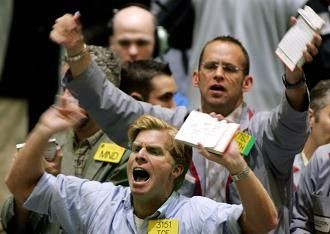Could a U.S. Default Push Oil Prices Above $130?
Analysis

Could the price of oil, already high at about $96 per barrel, rise above $150 if the U.S Government defaults on its debt?
Indeed it could. Here's why:
Oil, priced in dollars, tends to move higher as the U.S. dollar falls, and vice-versa. It's a result of oil traders trying to maintain their "purchasing power" in the event of a weaker dollar. Oil closed Friday down $1.58 to $95.86 per barrel.
Now if Democrats and Republicans in Washington can't reach a debt deal agreement and the U.S. Government defaults on its debt, the dollar may very well decline, boosting oil's price.
So far in the debt crisis, the dollar has held its own versus the euro, trading at $1.4410, but has declined versus the yen, to 76.84 yen, and the Swiss franc, to 0.7856 cents.
Further, if the U.S. Treasury Department has to postpone certain payment because it legally can not borrow money because the debt ceiling isn't raise, investors would likely drive the dollar lower against the world's other, major currencies.
How low could the dollar go? Different stress test modeles reveal different weaker-dollar scenarios. What's important is that a 10% decline in the dollar would probably push oil above $120 to $125 per barrel.
Add the start of the fall heating season in the northern hemisphere -- when oil demand historically rises -- and any additional trouble in the world's oil producing hot spots (Libya, Nigeria, Iraq, Iran, Venezuela) and the price of oil could easily push above $130 per barrel.
What's more, better-than-expected GDP growth occurs in the second hlaf of 2011 in emerging market countries, especially in China, India, Russia, and Brazil, and oil could vector even higher.
On the bearish side, the slow-down in U.S. GDP growth is expected to decrease oil demand in the gas-guzzling U.S., but if economic expansion re-gains steam, that would represent another oil-bullish factor.
Energy/Economic Analysis: An oil price above $130 per barrel would represent more bad news for U.S. motorists. Gas prices, which Friday averaged about $3.70 per gallon for regular unleaded, would rise substantially.
Gas prices rise about 2.5 cents for every $1 per barrel increase in the price of oil, so a $120 oil price would push U.S. regular unleaded to about $4.20 per gallon; a $130 price, to about $4.55 per gallon.
In addition, the U.S. economy would hurt. Every $1 per barrel rise in oil decreases U.S. GDP by about $100 billion per year and every 1 cent increase in gasoline decreases U.S. consumer disposable income by about $600 million per year.
To be sure, the flexible and resilient U.S. economy is more-energy efficient today that it was 10 years ago -- even five years ago -- and it will likely become more efficient in the years ahead, but that doesn't blot-out the fact that the U.S. remains an oil-dependent economy. Most cars still run on gasoline, trucks on diesel, and oil is also a major fuel for heat. Hence, sustained, high oil prices translate in to bad things for U.S. motorists, U.S. GDP, corporate earnings growth, and by extension, for most U.S. stocks.
Must Read: What would Harry Truman do to solve the U.S. debt cirisis if he was president today?
© Copyright IBTimes 2025. All rights reserved.





















